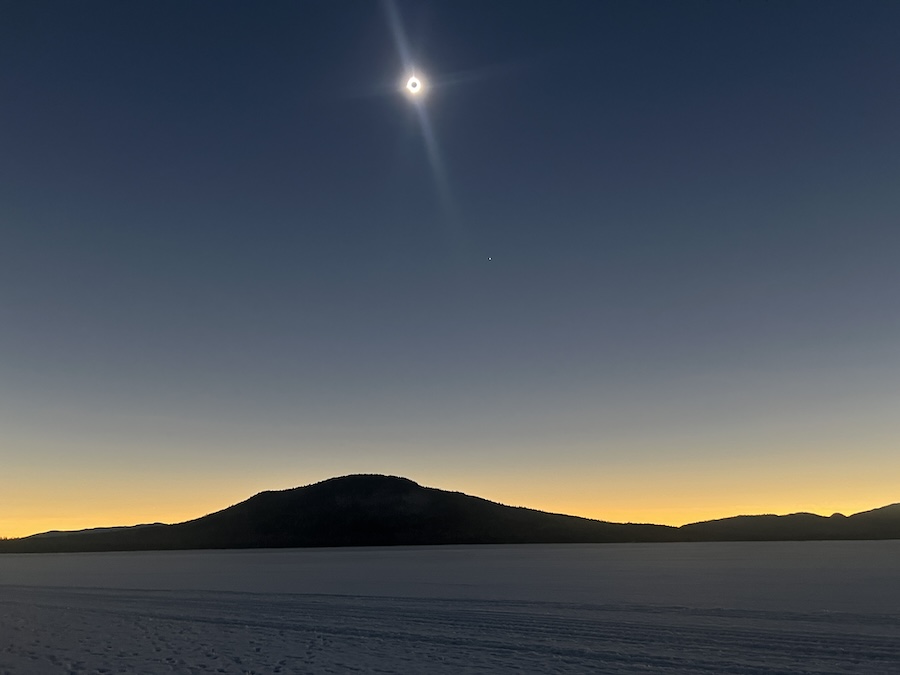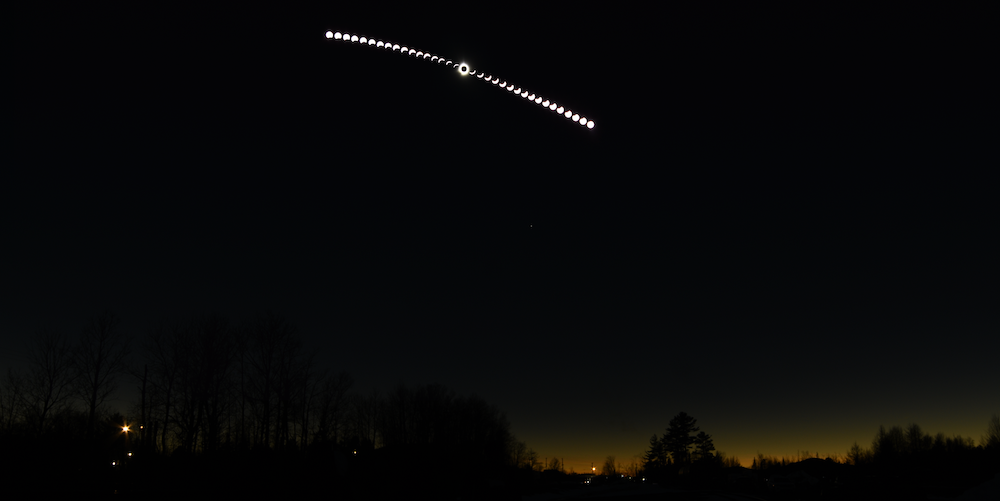Bowdoin Group Journeys to the Zone of Totality
By Rebecca Goldfine
When the black disc of the moon finally slipped into place in front of the sun around 3:30 p.m., casting the town and a long band across the state into murky shadow, the horizon began to glow pink, then yellow and orange.
With the sudden darkness, eclipse watchers spread along the lake's slushy rim erupted into cheers, then grew quiet as they gazed at the silvery arms of the sun's corona flowing out from behind the dark center. Fireworks crackled in the distance.
The extraordinary experience of totality was just three minutes and eighteen seconds long. Meanwhile, the trip to get there and see it took three-and-a-half hours, and double that time coming back, as Bowdoin's chartered bus hit bottlenecks of traffic at every little town along the way. Many thousands of eclipse viewers traveled into Maine's zone of totality to see the cosmic spectacle, setting up camping chairs on roadside pullovers and wherever they could.
Though long, the journey was worth it, especially for Fe McBride, assistant professor of physics, who organized the trip. With Bowdoin funding, she booked the bus and invited students from her astrophysics class (soon to be renamed Galaxies and Cosmology), before opening up the remaining seats to other members of the Bowdoin community.
"It was beautiful and I'm glad I was able to share this with students, faculty and staff," she said. "For me, it was worth the time and effort to reach the path of totality."











While science did occur during the eclipse—physics lab assistants measured the solar irradiance with a pyranometer and a physicist in the group checked the drop in air temperature—McBride said the trip was really a chance to appreciate a rare celestial sight. “We are so lucky to have a moon,” she said, noting that neither Mercury nor Venus has one, before adding, “and a moon that is the right distance and the right diameter to block the sun.”
Total solar eclipses are uncommon because of the slight tilt of the moon's orbit, which puts it in eclipse-creating alignment with the sun and earth only every few years. The students who joined the trip recognized the good fortune of being so close to a zone where you could see a full eclipse—rather than a 97 percent eclipse, as was the case in Brunswick. (Many more students watched on the quad or Schiller Coastal Studies Center, or traveled separately to the zone of totality.)
Liz Perot ’26 said she, "jumped at the opportunity" to join the Jackman trip. A physics and anthropology major, she's doing research with McBride this summer on active galactic nuclei.
Izzy Lockhart ’24, a French and biology major, and Nathan Oyeka '24, a computer science and physics major, agreed the event was unmissable, "a once-in-a-lifetime experience." Lockhard added, "And I'm excited to share it with all the people here today."
Gizem Dogan ’24, a physics and government major, also said it meant a lot to her to experience the eclipse with her classmates. "These are people I've taken classes with over the last four years, it makes it all the more special," she explained.





A Brief Historical, Cultural, and Scientific Journey through Eclipses
On the Wednesday before the eclipse, McBride gave a public talk about the phenomenon at the Portland Public Library. She titled her presentation, "When the Sun Throws Shade in Style."
McBride is an astrophysicist who researches supermassive black holes and their relativistic outflows of plasma (called jets), as well as "multimessenger connections between IceCube astrophysical neutrinos and galaxies." Her faculty page also emphasizes her interest in making science accessible.
In her presentation, she used diagrams and drawings to explain the rarity of total lunar events, and discussed the three types of eclipses—total, partial, and annular. She also delved into the history of eclipses, how they've been interpreted by cultures around the world, and their usefulness in pinpointing near-exact dates in ancient history.
One of her favorite eclipse legends comes from the Batammaliba people in northern Togo and Benin. While many cultures throughout time have feared eclipses as portents of misfortune and developed frightening stories to explain them (like dragons, or squirrels, eating the sun) the Batammaliba had a slightly more positive take.
In their legend, two of the first women in the world, mothers Puka Puka and Kuiyecoke, got tired of the fighting and negativity on earth—violence which they believed was spread by toxic bickering between the moon and sun. The mothers urged humans to stop warring, believing peace on the land would translate to a ceasefire between the moon and sun. For the Batammaliba, eclipses are a reminder of the sparring between moon and sun, and they use eclipses to "make amends for old feuds to encourage peace between the celestial bodies."
In more modern times, scientists have taken advantage of total solar eclipses to make new findings about the universe, including determining the distance between the earth and the moon. And during an 1868 eclipse, a scientist discovered a new element in the corona—helium, named for Helios, the Greek sun god.
Today, some earth scientists study how the atmosphere reacts to a very rapid decline of sunlight, providing insight into climate change and the speed at which the earth's atmosphere cools down.
Other scientists—and eclipse fans—take advantage of the opportunity of totality to actually see the corona, which is usually invisible because the body of the sun is so bright. "They are interested in the streams and plumes of solar material coming off the sun, and the solar winds," a continuous stream of charged particles, McBride said. "If there is a powerful amount of material, it can take out the electrical grid."
Finally, she said general relativity got a huge boost from an experiment in 1919, when two scientific expeditions in Africa and Brazil proved Einstein's theory of spacetime and the bending of light.
In general, however, eclipses are less relevant for science than they once were. But she added, "they are always worth taking the time to watch."
Photos by Rebecca Goldfine, unless otherwise noted.
“The moment totality ended and it immediately became very bright, it felt like a new beginning.”
—Fe McBride, assistant professor of physics


